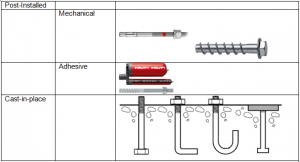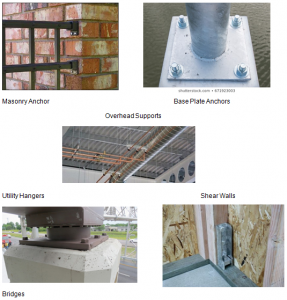The Understated Importance of Concrete Anchors
Concrete anchors are an essential design component for fastening structural items to reinforced concrete or masonry. Anchors are used to attach steel members to supporting concrete members. They are often overlooked and assumed to be a secondary design element. This week’s Fun Fact Friday will take a look at the types of anchors and design considerations each engineer must incorporate into their design.
American Concrete Institute (ACI) 318 Appendix D provides a strength design method for anchorage to concrete. The factors affecting the design of anchors are concrete strength (f’c), depth of embedment, thickness of concrete, edge distance, concrete reinforcement, anchor material grade and forces applied to the anchor. Seismic loads are also presented in the design guide.
Anchor suppliers have adopted the design methodology presented by ACI 318 and have design manuals and catalogs available to the designer for product data. Companies like Hilti, Red Head and Simpson Strong Tie have developed user-friendly computer programs that are interactive, allowing the designer to efficiently and easily navigate their designs.
Exploring the Two Types Of Concrete Anchors
There are two types of anchors: Post-installed and Cast-in.Cast-in anchors are bolts that are put in the concrete before it has set and dried. Post-installed anchor bolts are installed after the concrete is set in place and completely dried. There are two types of post-installed anchors, mechanical and adhesive. Mechanical post-installed anchors are inserted into pre-drilled holes, and then expand once in the concrete. Adhesive post-installed anchors are attached to the concrete using some type of adhesive product to bond the anchor to the concrete surface. The chart below shows examples of each.

Anchors in concrete are typically designed for Tension and Shear. Tension refers to when stress forces are applied to a surface using right angles, or perpendicular to the surface. Shear stress is when forces are applied parallel to the surface. Both tensile and shear failure have the potential to happen if the force exceeds the amount that the concrete is rated to handle. Specifically, the checks for concrete anchors are as follows:

Examples Of Concrete Anchors
There are several different examples of anchors, shown below:


If you have any questions about concrete anchors or require structural engineering design, contact Tom Gilmartin at (716) 592-3980 ext 120 or at tgilmartin@encorus.com.

